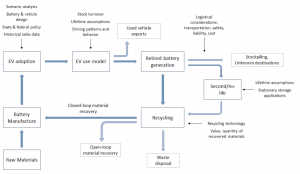Material Circularity
The transition to clean energy and sustainable transportation will require a substantial increase in demand for critical materials such as cadmium and rare earth elements for solar panels, and lithium, cobalt, and nickel for batteries. While they may not be associated with the same greenhouse gas emissions as fossil fuels, mining and refining these materials creates distinct environmental and social burdens in the producing countries. By proactively implementing end-of-life management strategies such as reuse and recycling, we can increase the “circularity” of these metals and inform climate change mitigation strategies that are truly sustainable and equitable on a global scale.
Team:
From left to right: Hanjiro Ambrose, Jessica Dunn, and Meg Slattery. Not pictured: Peter Benoliel, Tobiah Steckel, and Alissa Kendall (PI)
Research Projects:
AB 2832: Recycling Lithium-ion Vehicle Batteries Advisory Group:
- The AB 2832 group was convened by the State of California to advise the legislature on electric vehicle battery reuse and recycling policy. Our team provides the group with background information on battery design, recycling technologies, the reuse and recycling landscape, existing policy, and collection and transportation logistics.
- Learn more about the advisory group here
End-of-life EV Policy Simulator/System Dynamics Model
- Policy intervention is likely required to direct sustainable and safe end-of-life treatment of lithium-ion batteries. This research proposes to develop a dynamic systems model that integrates the economic, environmental, and social factors that shape the reverse logistics process and the economics of reuse and recycling to develop robust policy.
- Our model will consider reuse and recycling in the context of rapidly growing in-use stocks that include a diverse set of battery chemistries and architectures, and characterize environmental impacts and costs using life cycle methods. We employ a mixed-methods research approach incorporating interview-based qualitative research centering stakeholders in the vehicle afterlife ecosystem.
- This work is funded by the National Center for Sustainable Transportation
Managing Motor Vehicle Stocks and the Global Trade in Second-Hand Vehicles (World Bank)
- Second-hand vehicle flow characteristics impact greenhouse gas emissions, local air quality, road safety, and the fiscal sustainability of the importing country. Determining the characteristics and amount of motor vehicle stocks imported by countries is crucial for understanding on-road transport contributions and policies which drive decarbonization of the transportation sector of importing countries.
- Our approach involves tracing second-hand vehicle trade flows of importing and exporting countries. We will then analyze the data to better understand the market and/or policy drivers of these flows. The model produced will be used to develop a set of specific scenarios, in order to understanding the likely impact of efforts to decarbonize the fleet in the global north on carbon-emissions from vehicles in the global south.
Contact us!
- Jessica Dunn: jadunn@ucdavis.edu
- Meg Slattery: msslattery@ucdavis.edu


